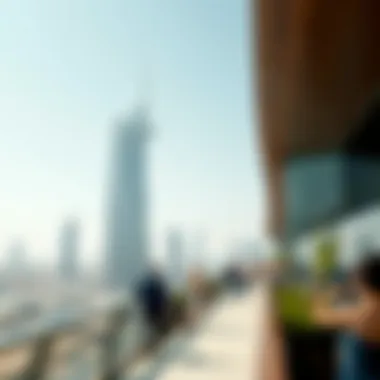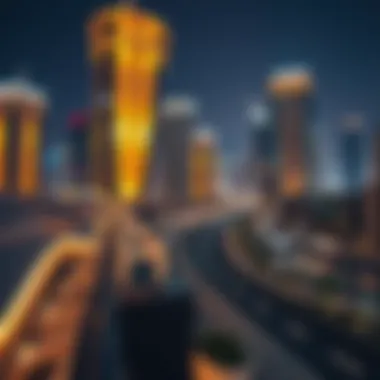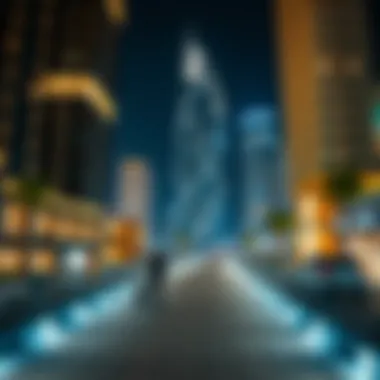Exploring Rooftop Citywalk: Dubai's Urban Innovation


Intro
Dubai has long been a city marked by its stunning architecture and innovative urban solutions. Among these developments, Rooftop Citywalk stands out as not only a testament to the city’s architectural prowess but also as a significant contribution to enhancing the urban experience. In a landscape known for extraordinary skyscrapers and bustling commerce, this distinctive integrated space invites communal engagement, serving as a refreshing break from the heat of the desert.
The appeal of Rooftop Citywalk lies in its versatile design, which marries modern aesthetics with functionality. It’s essential to explore this space, not just from a tourist’s lens, but to understand its deeper implications on real estate, urban planning, and community life.
As we delve deeper into this article, we will uncover the nuances of Rooftop Citywalk by discussing current market trends, historical performance, and strategies for potential investors. Aiming to provide a well-rounded view, we will look beyond the bricks and mortar to examine how such urban spaces shape social dynamics and foster community engagement. Through this exploration, we aim to equip property managers, investors, realtors, and developers with the insights needed to navigate the ever-evolving realm of Dubai's real estate.
Market Overview
Current Trends in Dubai Real Estate
Dubai’s real estate market has seen remarkable movements in recent years, shaped largely by shifts in global economic conditions, governmental policies, and the city’s growing stature as a cultural and economic hub. The appetite for both residential and commercial spaces continues to grow, as international investors see potential returns beckoning from the city’s vibrant economy.
In recent months, we have noticed a steady demand for high-end residences which have undergone design upgrades. Facilities that promote sustainable living and community engagement, such as Rooftop Citywalk, have become particularly attractive. This shift isn't just about buying properties; it also concerns the lifestyle they promote. Investors are now more cautious—opting for options that promise longevity and value appreciation.
Historical Market Performance


Over the last decade, the Dubai real estate market has had its ups and downs. Record-high prices in 2014 met a wave of correction shortly after, resulting in some trepidation among investors. However, the past few years have seen significant recovery, especially post-2020, when the demand for experiential living came into full swing.
As we analyze historical data, it becomes clear that urban spaces emphasizing community integration—like Rooftop Citywalk—tend to fare better in terms of resilience and value retention.
"Spaces that foster social connections and creativity often see better performance in market value than those that focus solely on luxury."
Moving forward, the real estate trajectory appears promising. Investors are finding new opportunities rooted in innovative developments, where harmony between architecture and community needs takes center stage.
Investment Strategies
Long-term vs Short-term Investments
In the realm of real estate, investors often grapple with the choice between long-term and short-term strategies. Long-term investments typically offer more stability, especially in a region like Dubai, that has shown resilience over the years despite occasional downturns. Meanwhile, short-term investments can yield quick returns but often come with higher risk.
In the context of spaces like Rooftop Citywalk, long-term investment might mean purchasing commercial space with the intention of cultivating a sustainable business rather than flipping properties quickly. Community-oriented developments are likely to attract footfall and foster a customer base which can lead to profitable business ventures.
Identifying Emerging Areas for Investment


As the property market adjusts to global trends, the importance of identifying emerging areas cannot be understated. Investors are advised to look for regions undergoing development or urban regeneration initiatives.
Rooftop Citywalk sits within an evolving urban landscape, making it a symbol and an opportunity for future growth. Areas around such innovative projects often attract ancillary businesses and create a ripple effect of economic activity. Surfing on the wave of growth linked to such spaces provides savvy investors with the means to potentially capitalize on value creation in the long run.
Preamble to Rooftop Citywalk
Rooftop Citywalk stands as a prominent figure in Dubai's architectural narrative, intertwining urban living with the essence of community engagement. This development isn't just about aesthetics; it's a vital part of transforming how city dwellers interact with their environment. In a bustling metropolis like Dubai, where every inch of real estate holds significant weight, the concept of repurposing rooftops into communal spaces is both innovative and necessary.
In this article, we will navigate through various elements of Rooftop Citywalk, shedding light on its design principles, the rationale behind its development, and its impact on the cultural fabric of the city. The design of urban spaces often mirrors the lifestyle of its occupants, making it crucial to understand the nuances embedded in this urban landscape.
Background and Development
The story of Rooftop Citywalk is not merely a tale of bricks and mortar. It reflects a gradual, deliberate evolution aimed at enhancing urban life. Initially conceptualized amid an era of rapid urbanization, this project was born out of a necessity for improved public spaces that cater to the growing population. The development incorporates elements that speak to both functionality and leisure—offering a variety of experiences, from quiet relaxation spots to bustling marketplaces.
Key milestones in this development include:
- Design Planning: Early phases focused on integrating the urban fabric with creative spatial solutions.
- Construction Innovations: New materials and sustainable practices were employed to nurture an environmentally friendly structure.
- Community Engagement: Feedback from potential users played a pivotal role in shaping amenities and features that resonate with the local demographic.


The Vision Behind Urban Rooftops
The vision for rooftop spaces like Citywalk transcends mere architectural novelty. Planners recognize that urban rooftops can serve as a bridge linking diverse communities within the city. By creating an accessible and inviting environment suitable for all ages, they tackle the common concern of urban isolation. The intention is clear: to foster a sense of belonging and interaction among residents.
Several key insights into this vision are:
- Encouraging Collaboration: Rooftop spaces can host events that bring together various cultural backgrounds.
- Promoting Sustainability: The incorporation of green technologies and eco-friendly designs showcases a commitment to responsible urban development.
- Cultural Enrichment: Art installations and communal activities add a layer of cultural texture, making these spaces vibrant hubs of creativity.
As we delve deeper into the following sections, the architectural significance and community implications of Rooftop Citywalk will unfold, illustrating its vital role in enhancing urban living in Dubai.
Architectural Significance
The evolution of urban development in recent years has made it vital to assess the architectural significance of spaces like Rooftop Citywalk. This area not only enhances the visual appeal of Dubai's skyline but also demonstrates groundbreaking ideas in architecture and urban design that meet modern needs. In an era where urbanization is rampant, such developments underscore the necessity for harmonizing aesthetics with functionality, invigorating both the environment and community living.
Innovative Design Elements
Integration with Landscape
When one thinks about urban spaces, a concrete jungle might come to mind. However, Rooftop Citywalk takes a different approach by intricately weaving nature into its architecture. The incorporation of green terraces, gardens, and natural water features results in a landscape that breathes life into a bustling city. This kind of integration enhances biodiversity, provides shade, and creates a welcoming environment for residents and visitors alike.
Moreover, this seamless blend between the man-made and the natural reinforces a positive relationship with the ecosystem, promoting environmental awareness.
A notable characteristic of this integration is its ability to offer residents a slice of nature without venturing far from urban conveniences. This way, the space becomes a desirable haven amidst Dubai's frenetic pace, allowing for relaxed interactions in a serene landscape.
Sustainable Practices
Sustainability is becoming a cornerstone in contemporary architecture, and Rooftop Citywalk doesn't shy away from this. The commitment to using energy-efficient systems, rainwater harvesting, and solar panels signifies a shift towards greener living. These sustainable practices not only reduce the carbon footprint but also lower utility costs, making it financially prudent in the long run.
One can’t overlook how such initiatives can lead to certifications like LEED or BREEAM, which further enhance property value and appeal to socially responsible investors.
While the initial investment in these technologies might be steep, the long-term benefits—both financially and environmentally—are substantial. This conscious choice aligns perfectly with Dubai's vision for a sustainable future, enhancing the credibility of urban developments.
Use of Modern Materials
The advent of modern materials has transformed conventional architectural practices. At Rooftop Citywalk, the use of innovative materials such as translucent concrete, high-performance glass, and recycled substances is evident. These materials not only lend aesthetic appeal but also have practical advantages, including energy efficiency and durability.
- Translucent concrete: Allows natural light while maintaining privacy.
- High-performance glass: Reduces heat gain and loss, optimizing energy consumption.
- Recycled materials: Reduces environmental impact and showcases a commitment to sustainability.



